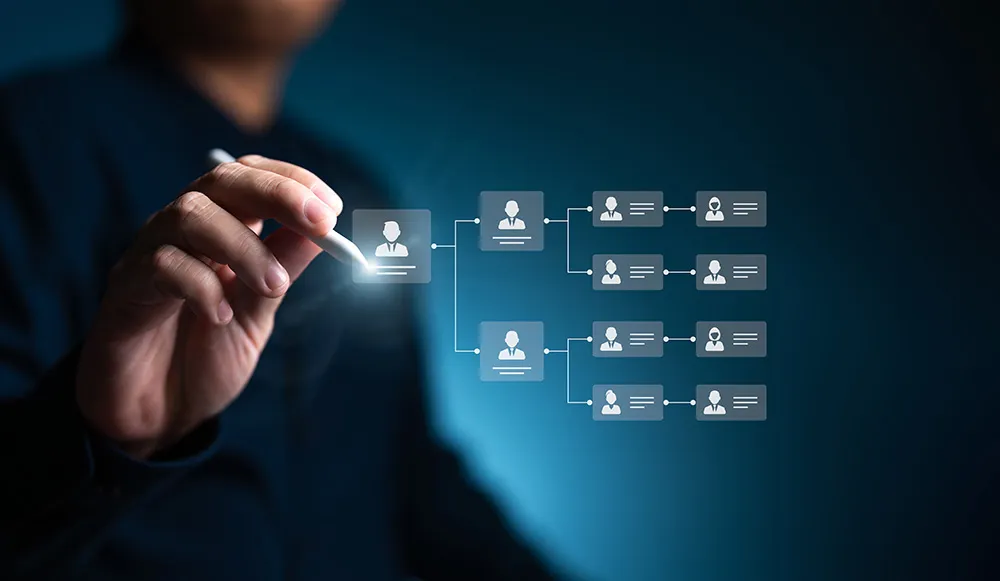Since the arrival of ChatGPT in November 2022, the debate over the impact of Artificial Intelligence (AI) on employment has stopped being speculative. Are we facing a revolution that will enhance human productivity, or the most serious threat of technological unemployment in decades?
The recent study “Canaries in the Coal Mine? Six Facts about the Recent Employment Effects of Artificial Intelligence”, by Erik Brynjolfsson, Bharat Chandar, and Ruyu Chen (Stanford University, 2025), provides for the first time large-scale empirical evidence of what is happening in the U.S. labor market.1
The result: six key findings that should interest any executive, policymaker, or talent leader.
The key findings
- A sharp drop in youth employment in exposed occupations. Between 2022 and 2025, employment of 22–25-year-olds in highly exposed jobs such as software development and customer service fell by 13%. In contrast, employment of workers over 35 in those same fields increased.
- The labor market is growing, but young people are stalling. While overall employment in the U.S. remains solid, growth among younger workers has flattened in the most AI-exposed quintiles. In less exposed occupations, young people are advancing at the same pace as adults.
- Automation vs. augmentation: the critical difference. Job losses are concentrated in tasks fully automated by AI—such as automatic debugging or code generation without human intervention. Where AI complements—teaching, iterating, validating—employment holds steady or even grows.
- Not a sectoral or transitory phenomenon. Even when controlling for firm-specific factors, the decline persists: 12 log points fewer jobs in the most exposed quintiles. This rules out the possibility that it is only a macroeconomic shock or a post-pandemic “tech winter.”
- The adjustment happens through employment, not wages. Pay levels barely change. The adjustment is silent: fewer hires and more layoffs, but no salary cuts—at least for now.
- This is a structural phenomenon. The patterns remain even when excluding the tech sector and remote work, and when extending the data series to years before the adoption of generative AI. Everything indicates we are facing a structural transformation of the labor market.
The “silver lining”: Augmentation
The third finding is the most encouraging: when AI complements instead of replacing, jobs not only hold but can grow. Brynjolfsson et al. measure this through the Anthropic Economic Index, which classifies AI use into two categories: automative (substitutive) and augmentative (complementary).
Augmentative AI improves human performance without replacing it: copilots that suggest but don’t decide, algorithms that detect errors for humans to fix, systems that accelerate idea generation but leave validation to people.
The results show that in the quintiles with the highest augmentation, youth employment shows a more positive trajectory than in less exposed occupations.
As long as AI use is of the type ‘task iteration,’ ‘learning,’ or ‘validation,’ we observe that young people do not lose jobs and even gain participation in the occupation.
—Brynjolfsson, Chandar & Chen (2025)
Skills for the future
The study concludes that young workers are most at risk because their value comes mainly from codified knowledge—the easiest for AI to replace. To sustain employability, it is crucial to develop complementary skills:
- Critical and contextual thinkingto interpret results and detect biases.
- Prompt design and strategic use of AI to obtain useful outputs.
- Algorithmic project management, focusing on results for stakeholders.
- Creativity and storytelling, turning data into persuasive narratives (something machines still cannot replicate with subtlety).
- Social and leadership skills, indispensable in hybrid human–machine teams.
From alarm to action
The study by Brynjolfsson et al. warns us that AI is already reshaping the labor market, and that younger workers in routine roles are the first affected. But it also shows there is a way out: design systems that enhance rather than replace, invest in talent, and bet on hybrid models of human–AI collaboration.
In Peru, where digital transformation is only beginning, this is an opportunity not to repeat the mistakes of past technological revolutions.
(1) The authors analyzed payroll data from 3.5 to 5 million workers per month, across tens of thousands of ADP client companies—the largest payroll software provider in the U.S. This dataset allowed them to track employment by age, occupation, and degree of AI exposure with unprecedented detail.
.webp)
.svg)



.webp)



